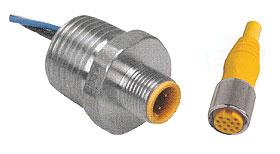Ultrasonic Flow Transmitters Designed For Process Applications
Description
Clark Solutions announces the availability of a new line of ultrasonic flow transmitters ideally suited for use in process systems. These transmitters are easy to install, do not impact the flow, pressure, or transit times of fluids, and are unaffected by fluid temperatures or viscosities, making them ideal for measuring flow ranges from 4.5 to 3000 GPM in 4” to 10” pipe.
Like all Clark Sonic Ultrasonic Flow Transmitters, Model CSLFC Transmitters feature no moving parts, excellent long-term stability, no pressure drop, and high accuracy at a lower cost than similar instruments. Built out of Schedule 40 epoxy coated carbon steel, CSLFC Transmitters feature ULTEM® encapsulated ultrasonic transducers with a choice of EPDM, Buna-N, Neoprene™, FKM, or other seals. Clark Sonic Model CSLFC Transmitters provide a continuous 4-20mA flow signal. Available options include direction of flow capability, NEMA 4 and 8 pin connector receptacles for simplified installation, and a DP/DS Panel Meter/Display. Model CSLFC Transmitters are available for purchase online at http://www.clarksol.com/html/cslfc.cfm <http://www.clarksol.com/>
At the heart of the Clark SonicUltrasonic Flow Transmitter is a proprietary mixed signal ASIC, (Application Specific IC,) which allows sophisticated timing, control and transducer drive circuitry to be combined on a single integrated circuit. The ASIC uses a special algorithm that is an improvement upon the standard single-path measurement technique. Clark ultrasonic transmitters utilize the “sing around” method, where each ultrasonic transducer alternates between transmitting and receiving to measure differences in flight time between upstream and downstream transmissions. The flight time of the sound pulse from the transmitting transducer to the receiving transducer will be shortened if the pulse is launched in the direction of flow, and increased if launched opposite to the direction of flow. By alternating the transmitting and receiving transducers, the difference in these transit times can be used to calculate the velocity of the flow, which, when multiplied by the area of the pipe, results in a measure of volumetric flow rate. The primary advantage of the “sing around” method is that the velocity of the fluid is being measured independent of the relative speed of sound in that given fluid. The output of Clark transmitters is also unaffected by changes in water temperature, density, and viscosity.
Like all Clark Sonic Ultrasonic Flow Transmitters, Model CSLFC Transmitters feature no moving parts, excellent long-term stability, no pressure drop, and high accuracy at a lower cost than similar instruments. Built out of Schedule 40 epoxy coated carbon steel, CSLFC Transmitters feature ULTEM® encapsulated ultrasonic transducers with a choice of EPDM, Buna-N, Neoprene™, FKM, or other seals. Clark Sonic Model CSLFC Transmitters provide a continuous 4-20mA flow signal. Available options include direction of flow capability, NEMA 4 and 8 pin connector receptacles for simplified installation, and a DP/DS Panel Meter/Display. Model CSLFC Transmitters are available for purchase online at http://www.clarksol.com/html/cslfc.cfm <http://www.clarksol.com/>
At the heart of the Clark SonicUltrasonic Flow Transmitter is a proprietary mixed signal ASIC, (Application Specific IC,) which allows sophisticated timing, control and transducer drive circuitry to be combined on a single integrated circuit. The ASIC uses a special algorithm that is an improvement upon the standard single-path measurement technique. Clark ultrasonic transmitters utilize the “sing around” method, where each ultrasonic transducer alternates between transmitting and receiving to measure differences in flight time between upstream and downstream transmissions. The flight time of the sound pulse from the transmitting transducer to the receiving transducer will be shortened if the pulse is launched in the direction of flow, and increased if launched opposite to the direction of flow. By alternating the transmitting and receiving transducers, the difference in these transit times can be used to calculate the velocity of the flow, which, when multiplied by the area of the pipe, results in a measure of volumetric flow rate. The primary advantage of the “sing around” method is that the velocity of the fluid is being measured independent of the relative speed of sound in that given fluid. The output of Clark transmitters is also unaffected by changes in water temperature, density, and viscosity.
Specs
• Flow Range: Bi-directional, field selectable per "Standard Models" table • Accuracy: ±0.75% of full scale • Operating Temperature: -40 to 190°F (-40 to 87.8°C) • Response Time: User selectable, 2 or 10 seconds • Viscosity Range: 0.2 to 150 cSt (0.2 to 150 mPas) • Liquid Density: 30.6 to 74.9 lb/cu.ft. (490 to 1200 kg/m3) • Max. Working Pressure: 200 PSI (13.8 bars) • Pipe Sizes: 4", 6", 8", 10" • Pipe Connections: ASME class 150 flange • Electrical Enclosure: Integral to Body casting with gasketed cover; One 1/2" • NPT conduit connection (plugged when model ordered with metric threads) • and one M16 x 1.5 connection (plugged when model ordered with NPT threads) • Electrical Connections: Screw terminal connections on PC board • Enclosure Rating: NEMA 4 (IP 65) • Power: 18 to 36 VDC


